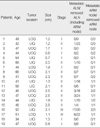Abstract
Purpose
The aim of this study was to confirm the feasibility of the technique, the so called "axillary reverse mapping (ARM)", and to test the hypothesis that the arm lymphatics are never involved by the metastatic process of breast cancer.
Methods
We reviewed the prospectively maintained database of 129 patients who underwent an operation for breast cancer. Blue dye was injected in the upper inner arm to identify the draining lymphatics or lymph nodes from the arm. During the axillary procedure, we found the "blue" ARM node and the "hot" sentinel lymph node (SLN). The histological results of the ARM nodes were compared with those of the other nodes harvested in SLN biopsy (SLNB) or axillary lymph node dissection (ALND).
Results
The ARM nodes were identified in 78.3% (101/129) of the patients. The ARM nodes were identified in 71.6% (58/81) of the patients with SLNB and in 88.4% (38/43) of the patients with SLNB followed by ALND and in all cases with ALND. In 19 of the 96 SLNB cases, the ARM nodes were hot or the SLNs were blue (concordant case), yielding an 18.9% concordant rate between the ARM node and the SLN. Among these 19 concordant cases, 7 ARM nodes contained metastasis (36.8%). But in the 77 non-concordant cases, only one ARM node was positive for metastasis (1.3%) in a heavily metastasized axilla. The ARM nodes were identified in all five ALND cases, and one ARM node was positive for metastasis.
Conclusion
It is thought that lymphatic drainage from the arm can share common lymphatic channels in the axilla with lymphatic flow from breast, and these concordant ARM nodes may be involved by the metastatic process of breast cancer. However in the non-concordant cases, ARM nodes will be free from the danger of axillary dissection.
Figures and Tables
 | Figure 1Identification of a blue ARM node (arrow) in relation with the lymphatic drainage (arrowheads) from arm in the axilla. |
References
1. Carter CL, Allen C, Henson DE. Relation of tumor size, lymph node status, and survival in 24,740 breast cancer cases. Cancer. 1989. 63:181–187.

2. Ivens D, Hoe AL, Podd TJ, Hamilton CR, Taylor I, Royle GT. Assessment of morbidity from complete axillary dissection. Br J Cancer. 1992. 66:136–138.

3. Newman ML, Brennan M, Passik S. Lymphedema complicated by pain and psychological distress: a case with complex treatment needs. J Pain Symptom Manage. 1996. 12:376–379.

4. Tasmuth T, von Smitten K, Kalso E. Pain and other symptoms during the first year after radical and conservative surgery for breast cancer. Br J Cancer. 1996. 74:2024–2031.

5. Giuliano AE. Lymphatic mapping and sentinel node biopsy in breast cancer. JAMA. 1997. 277:791–792.

6. Giuliano AE, Jones RC, Brennan M, Statman R. Sentinel lymphadenectomy in breast cancer. J Clin Oncol. 1997. 15:2345–2350.

7. Blanchard DK, Donohue JH, Reynolds C, Grant CS. Relapse and morbidity in patients undergoing sentinel lymph node biopsy alone or with axillary dissection for breast cancer. Arch Surg. 2003. 138:482–487.

8. Haid A, Köberle-Wührer R, Knauer M, Burtscher J, Fritzsche H, Peschina W, et al. Morbidity of breast cancer patients following complete axillary dissection or sentinel node biopsy only: a comparative evaluation. Breast Cancer Res Treat. 2002. 73:31–36.

9. Leidenius M, Leivonen M, Vironen J, von Smitten K. The consequences of long-time arm morbidity in node-negative breast cancer patients with sentinel node biopsy or axillary clearance. J Surg Oncol. 2005. 92:23–31.

10. Mansel RE, Fallowfield L, Kissin M, Goyal A, Newcombe RG, Dixon JM, et al. Randomized multicenter trial of sentinel node biopsy versus standard axillary treatment in operable breast cancer: the ALMANAC Trial. J Natl Cancer Inst. 2006. 98:599–609.

11. Rönkä R, von Smitten K, Tasmuth T, Leidenius M. One-year morbidity after sentinel node biopsy and breast surgery. Breast. 2005. 14:28–36.

12. Schrenk P, Rieger R, Shamiyeh A, Wayand W. Morbidity following sentinel lymph node biopsy versus axillary lymph node dissection for patients with breast carcinoma. Cancer. 2000. 88:608–614.

13. Swenson KK, Nissen MJ, Ceronsky C, Swenson L, Lee MW, Tuttle TM. Comparison of side effects between sentinel lymph node and axillary lymph node dissection for breast cancer. Ann Surg Oncol. 2002. 9:745–753.

14. Lee JS, Hong SJ, Kim HJ, Chang MA, Sung IY, Gong KY, et al. Comparison of early postoperative axillary morbidity following the sentinel lymph node biopsy or axillary lymph node dissection. J Breast Cancer. 2007. 10:107–113.

15. Thompson M, Korourian S, Henry-Tillman R, Adkins L, Mumford S, Westbrook KC, et al. Axillary reverse mapping (ARM): a new concept to identify and enhance lymphatic preservation. Ann Surg Oncol. 2007. 14:1890–1895.

16. Nos C, Lesieur B, Clough KB, Lecuru F. Blue dye injection in the arm in order to conserve the lymphatic drainage of the arm in breast cancer patients requiring an axillary dissection. Ann Surg Oncol. 2007. 14:2490–2496.

17. Hama Y, Koyama Y, Urano Y, Choyke PL, Kobayashi H. Simultaneous two-color spectral fluorescence lymphangiography with near infrared quantum dots to map two lymphatic flows from the breast and the upper extremity. Breast Cancer Res Treat. 2007. 103:23–28.





 PDF
PDF ePub
ePub Citation
Citation Print
Print







 XML Download
XML Download